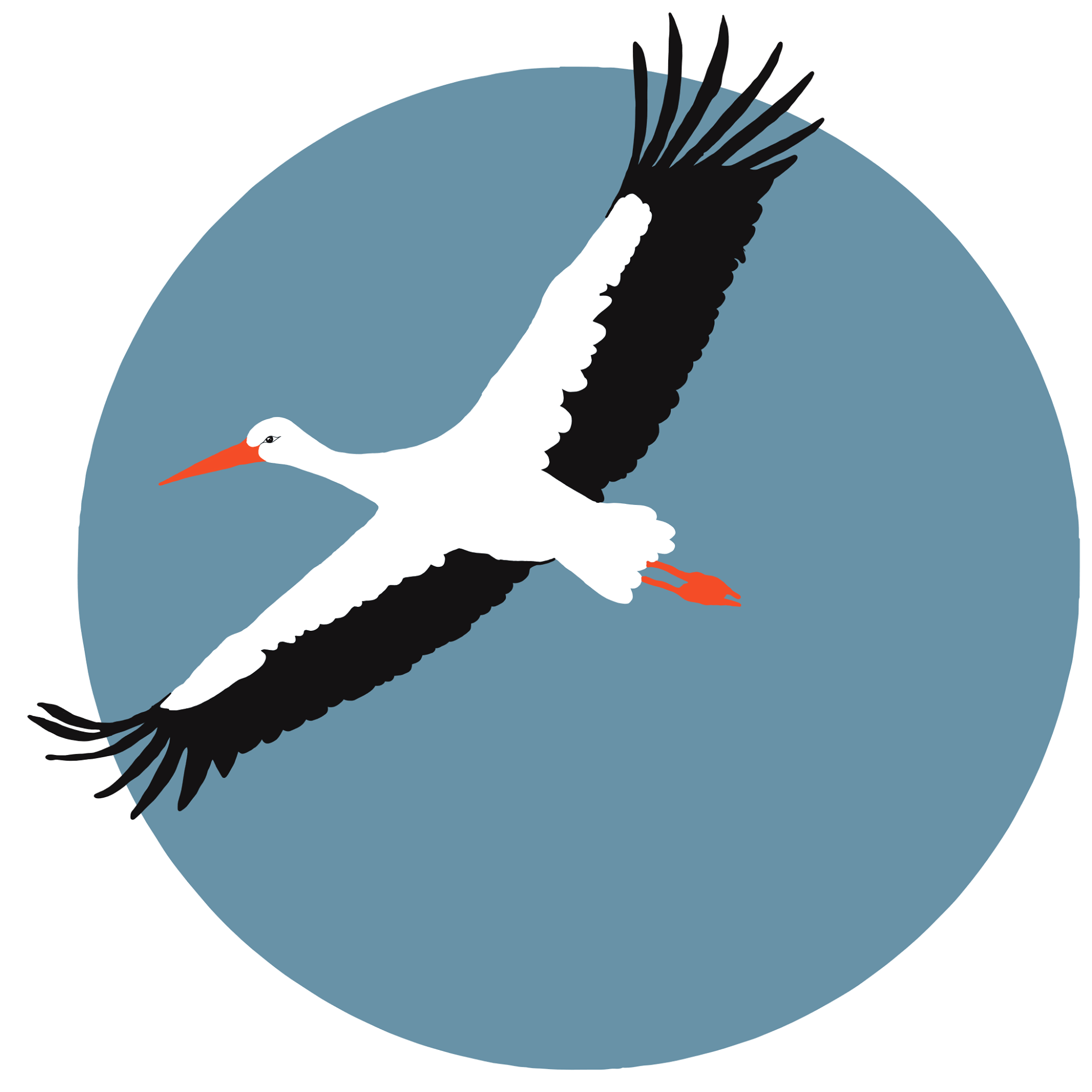News
2023 – A Storkingly Good YearHere at the White Stork Project, we’re excited to bring you an update of this season’s stork news. In 2020, Knepp became home to the first wild storks to breed in the UK for over 600 years, and they continue to delight, amaze and educate us.
The project has gone from strength the strength, from just 2 nesting pairs in 2020 increasing to 9 successful nests last year. This year, we have been thrilled to share that 26 chicks fledged from 11 nests across the Knepp Estate.
An impressive 29 chicks hatched in spring across 11 nests. Most exciting of all were chicks hatched in nests built by some of our flightless birds. These birds were introduced at the start of the project to provide a ‘magnet’ population, intended to tempt in any wild storks flying over the area. They came to Knepp from Poland having been the victims of car accidents or collisions with power lines. Their home is a spacious open-topped area where they freely mingle with wild flying birds. But the flightless birds had never nested – until this year, that is. One pair included a flyer and a non-flyer – possibly the first in history!
Making sure that our ‘ground nest’ chicks were progressing well was a particularly interesting part of the season for the stork volunteer team, who have continued to be an integral part of the project. As the chick’s parents could not all forage outside of the pen, we gave these chicks a small amount of supplementary food each morning. This involved some training from the fantastic team at the Cotswold Wildlife Park who have a successful population of storks rearing young on ground nests. Using their techniques, we daily visited our two ground nests and as a result got to know the birds quite well through these short interactions. On one nest, we had a male and female chick who behaved predictably at every visit; the male (GBC6) would invariably greet the volunteers with screeching and snapping, while the female (GBC7) played dead as soon as she noticed us. She would only feed once the visitors were leaving. Both of these chicks have been satellite tagged and we are excited to learn about their movements over the coming months and years.
The weather was kinder than in 2022 with no nests destroyed by spring storms, but the early drought made finding food challenging for the parent birds. But by July, 26 chicks had successfully fledged, including three chicks from the ground nests. This means an impressive total of 68 chicks have fledged at Knepp from the project so far.
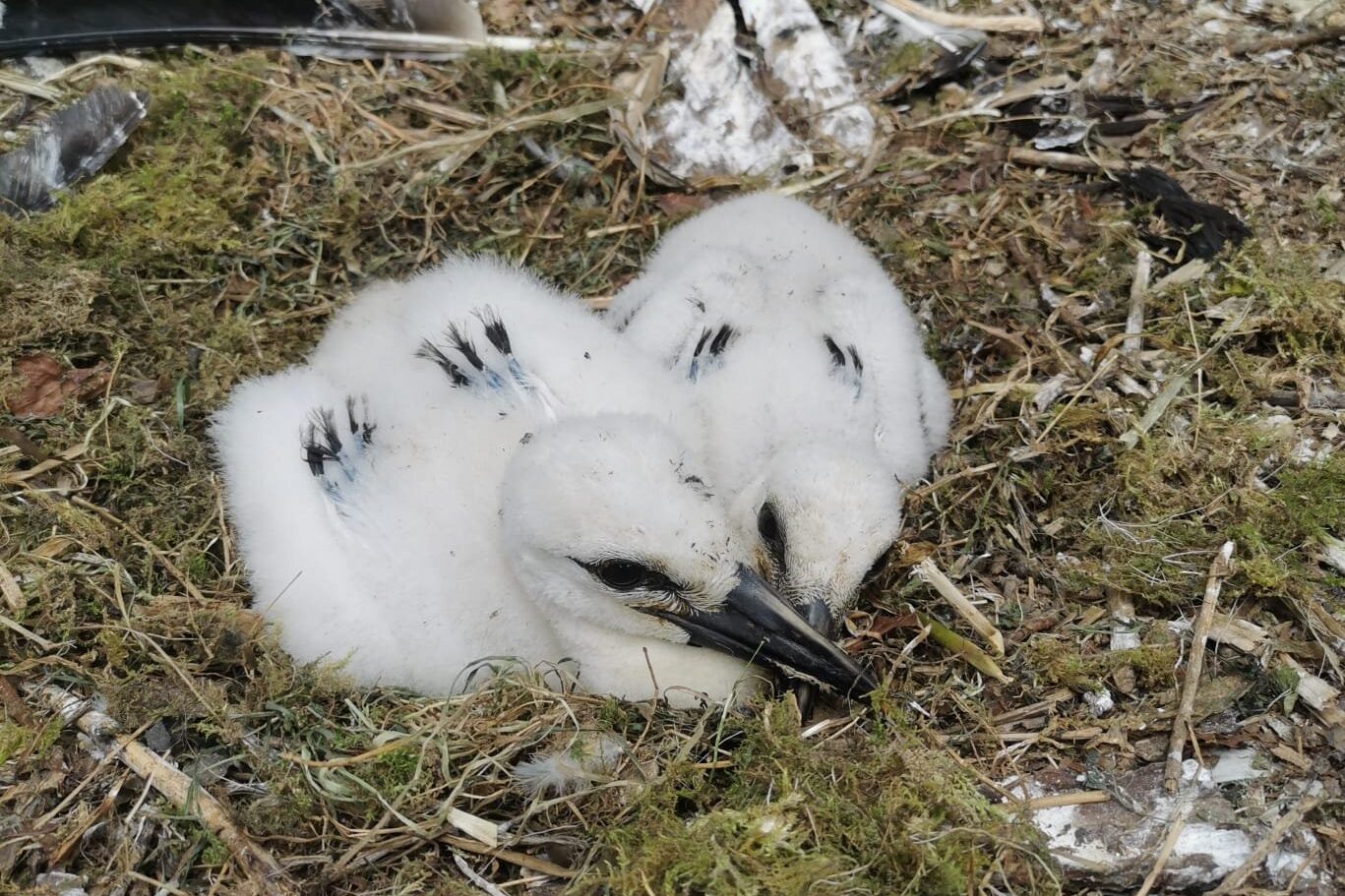
Ground nest chicks
GBC6 on the left, a male, and GBC7 on the right, a female. These chicks fledged on the same morning.
The moss, lichen and feathers in the image on the left were placed there by the attentive parents who did a fantastic job of making sure the chicks were comfortable and well cared for.
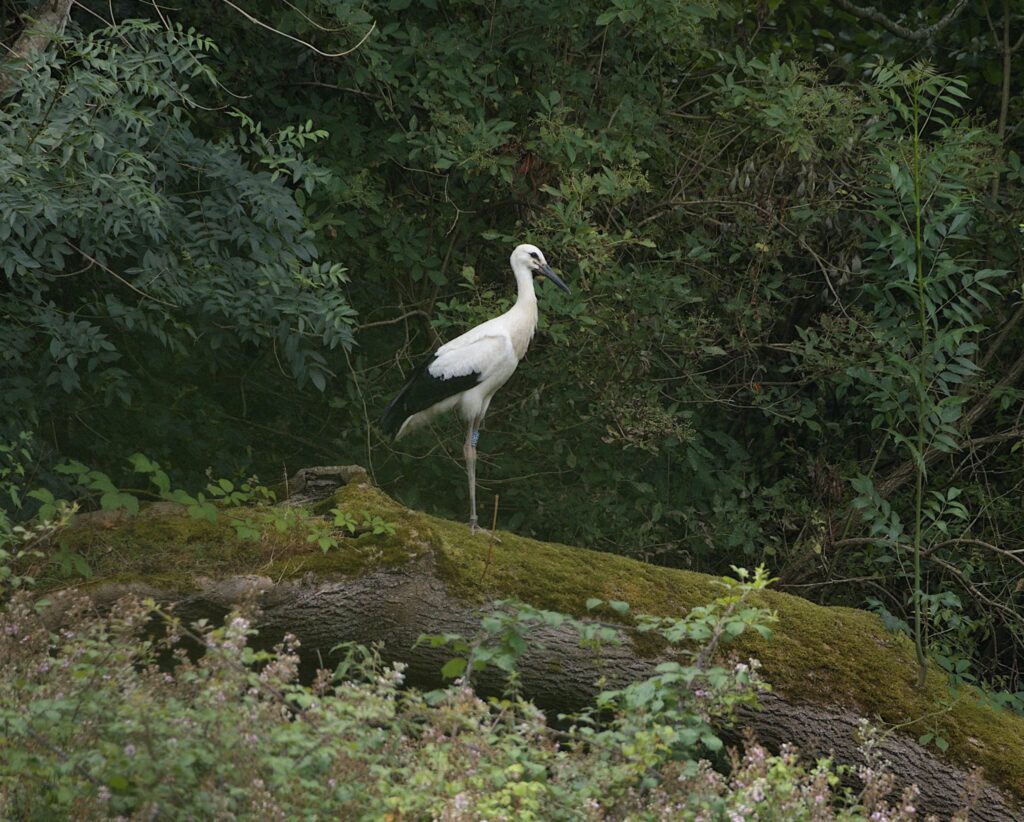
A juvenile white stork, identifiable by it’s black beak which turns orange/red over the first year.
Photo credit: Dawne Davis
Many people ask what happens to our juvenile storks after fledging. We are lucky enough to be able to fit GPS trackers onto some of our chicks. We are grateful to the Cotswold Wildlife Park as well as our local supporter, Skylark Coffee, for sponsoring these trackers. It’s a tricky process, as the lofty nests usually must be accessed by means of a cherry picker. However, it’s well worth the effort as the trackers transmit the birds’ location so we can follow their movements. This year, we were hugely grateful to Jon Ginn from Ashdown Spider Lift who not only let us borrow his fantastic spider lift machine to access the nests, but also treated a couple of the volunteers to a quick and beautiful evening view of the Knepp Estate from nearly 30 meters! As ever we also enjoyed working with Jeremy the tree climber who continues to impress us with his ability to scale the mature oaks that a machine can’t get to, and safely retrieve our stork chicks for ringing.
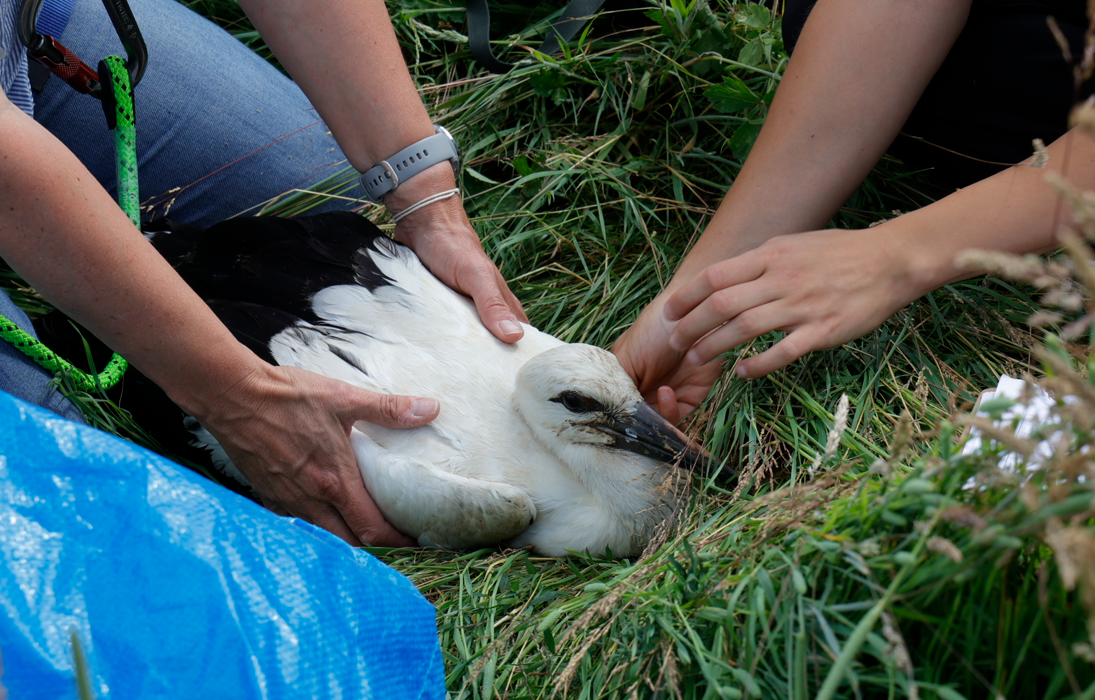
A juvenile white stork, identifiable by it’s black beak which turns orange/red over the first year.
Photo credit: Dawne Davis
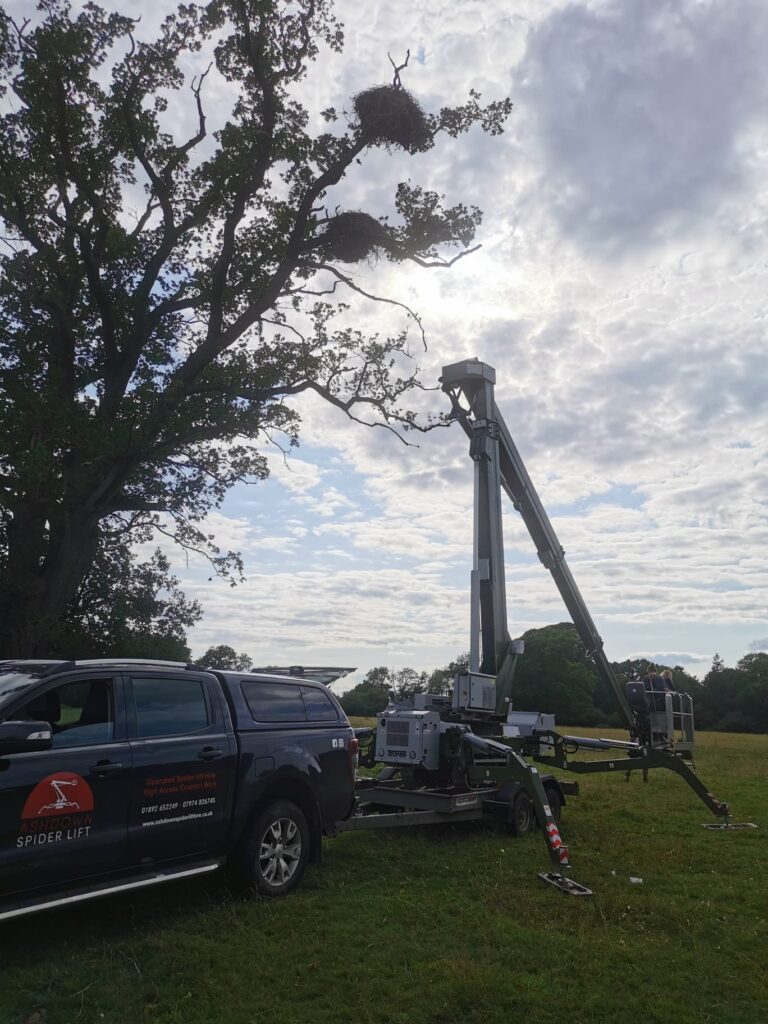
Double decker nesting
At Knepp, the storks have chosen to build their nests in large oak trees. The tree pictured on the left is home to two stork nests. The nests themselves are made of oak branches and twigs as well as hazel, blackthorn, willow and other material. Reaching these nests involves the use of special machinery.
All chicks are ringed with a unique number, which can be found on the upper left leg and comes on a navy blue Darvic ring. Anyone observing a bird is encouraged to send in their observations, via this website, so we can build up a better picture of where the birds have travelled to. Studying the behaviour of storks in Europe, we would expect chicks to migrate to Southern Spain or Morocco via France in late summer, remaining there until they’re ready to breed, when they return to their birthplace. In previous years, sometimes the chicks have migrated, and sometimes they’ve stayed close to home. We can only guess why – it’s probably a combination of weather conditions and availability of food.
White storks rely on the ability to forage a huge range of prey items including invertebrates, amphibians and occasionally even small mammals and reptiles. The quality of the habitat they live in and move through on migration is crucial to their success. In particular, wetlands and grassland with areas of scrub provide storks with a diverse food source.
Every year, the wild chicks at Knepp are joined by other fledglings hatched to flightless parents at project partner Cotswold Wildlife Park. It’s always a heartwarming sight to see these and other rescue birds take to the air for the first time when they are released at Knepp. This year we released 33 birds from Cotswold Wildlife Park, and they were quick as a flash out of the starting block when the door to their pen was opened, soaring over Knepp Wildland seconds after their release. It was incredible to see our wild adults and juveniles mixing with these birds. Even more astonishingly, a matter of days after taking their first flight, some had set off on their migration across the Channel, with the first bird reaching southern Spain within two weeks.
Meanwhile, Knepp-hatched juveniles have been exploring the UK, flying up above East London and west along the coast as far as Portsmouth. So don’t forget to keep your eyes peeled on the sky as there might just be a stork flying by!
We’ll bring you the latest updates on our birds’ travels as soon as we can.
We were delighted to have such a successful year and are already starting to look ahead to 2024. The project is in the process of developing some live mapping, so that anyone interested will be able to view the incredible journeys more closely.
We are also developing our educational/outreach offer and are planning to engage with schools (both in the UK and across Europe) to share this inspiring story of nature recovery. If you are interested in hearing more about this, do get in touch with us via the website.
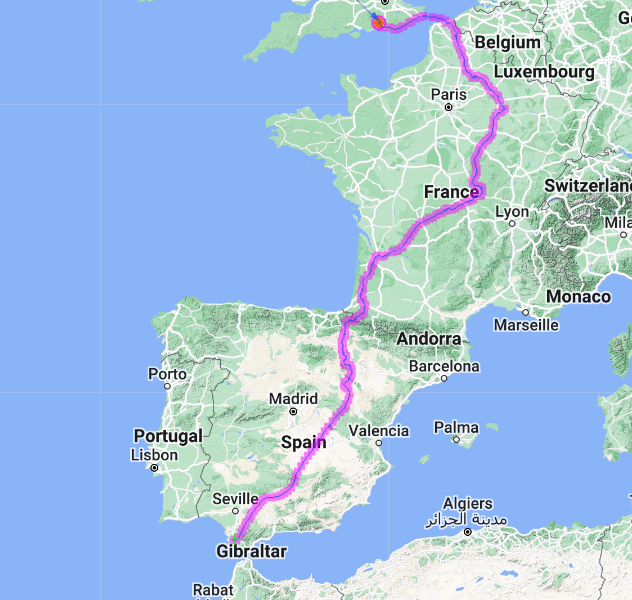
An impressive journey
GBE4, a female hatched at the Cotswold Wildlife Park and released at Knepp embarked on this phenomenal journey after only around 1 week of being able to fly.
The journey from the South of the UK down to Gibraltar itself took around 2 weeks.
